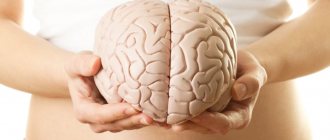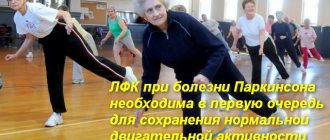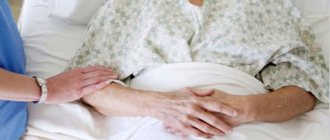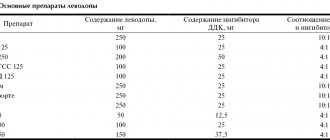general information
Parkinson's disease affects men twice as often as women. In most cases, it develops after 60 years of age, but cases of early onset of the disease are recorded (at 30-40 years of age), as well as juvenile forms that develop in people in their twenties.
There are several hypotheses for the formation of pathology. It has now been precisely proven that one of the mechanisms of its development is the gradual degeneration of neurons and a decrease in the production of dopamine. It is an important neurotransmitter involved in the transmission of nerve impulses. As a result, a specific set of disorders is formed, which makes it easy to make a diagnosis.
Causes
The exact causes of Parkinson's disease have not been identified. Scientists have been able to identify only a number of factors that increase the risk of developing neurodegenerative processes:
- natural processes of aging of the body, accompanied by a decrease in the ability of tissues to regenerate;
- genetic predisposition (this is especially true for forms with early onset);
- chronic lack of vitamin D, which protects neurons from the pathological effects of toxins;
- intoxication with salts of heavy metals, pesticides, alcohol;
- poor environmental conditions in the region of residence;
- taking certain medications (for example, chlorpromazine);
- chronic insufficiency of blood supply to the brain (due to atherosclerosis, osteochondrosis of the cervical spine, etc.);
- infections affecting the central and peripheral nervous system (meningitis, encephalitis, herpes viruses, influenza);
- brain tumors;
- traumatic brain injuries;
- smoking;
- frequent and prolonged stress, chronic fatigue.
Make an appointment
Causes and predisposing factors
There are several hypotheses that highlight different causes of Parkinson's disease. It is believed that the main factor is a hereditary predisposition, so the likelihood of developing pathology increases if it is present in the anamnesis of relatives. In addition, external factors also influence the cells of the nervous system. These include chemical agents that react with neurons, causing their hypoxia (oxygen starvation) and death. Among such substances, MTPP (1-methyl-4-phenyl-1,2,3,6-tetrahyropyridine) is isolated, with injections of which the symptoms and signs of Parkinson’s disease sharply worsen.
Another factor that can cause Parkinson's disease is a decrease in the production of the hormone dopamine. It is a biochemical precursor of catecholamines (adrenaline and norepinephrine) and is synthesized in neurons. Its deficiency can affect the processes of oxygen metabolism in brain tissue, which causes the first signs of Parkinson's disease. According to statistics, this disease develops less often in smokers than in non-smokers. This fact is explained by the increased formation of dopamine during smoking.
It is also believed that the disease may develop as a result of pathological lipid oxidation reactions. They occur with the participation of free radicals - any environmental factors that can enter into biochemical reactions with the cells of the body and cause the destruction of their membranes. The action of free radicals is neutralized by antioxidants - endogenous compounds. Violation of their production causes progressive destruction of cellular elements, their premature aging and apoptosis - programmed death.
Symptoms
Parkinson's disease is manifested by specific symptoms, which together form a clear picture of the disease:
- tremor: fine trembling begins in one hand and then spreads to both limbs and head; the movement of the fingers is somewhat reminiscent of counting coins; while performing purposeful movements (for example, while working at a computer);
- general slowness of movements (bradykinesia): the patient often freezes in one position;
- specific gait: a person moves with small, shuffling steps, as if he is constantly on very slippery ice;
- poor facial expressions: a mask effect is formed due to low mobility of facial muscles;
- monotonous, quiet speech;
- increased muscle tone (muscle rigidity): the figure becomes stooped, arms and legs are slightly bent, the head is tilted forward;
- postural instability: a person has difficulty starting and ending movements, resulting in decreased ability to maintain balance;
- disorders of the autonomic nervous system: oily skin, excessive secretion of saliva and sweat;
- decreased sense of smell;
- constipation, urinary disorders.
Unlike other neurodegenerative diseases, Parkinson's disease has little effect on intelligence in early and middle stages of development. As the pathology progresses, there is a decrease in the speed of thinking and speaking, decreased mood, depression and indifference to everything that happens.
Symptoms of Wilson-Konovalov disease in adults
Possible manifestations are very diverse.
Most often, the liver is affected (about 40 - 50% of cases), and in other cases, neurological damage and mental problems may occur. When the nervous system and vision are damaged, a typical symptom appears - the manifestation of the Kayser-Fleischer ring (occurs due to the deposition of copper in the iris with its specific brown coloration). In the abdominal form of the disease, symptoms usually appear closer to 40 years of age. Among the key features:
- cirrhosis of the liver;
- chronic or fulminant (fulminant) hepatitis.
In childhood, the rigid-arrhythmohyperkinetic variant of the disease occurs more often.
It begins with rigidity (compaction, poor compliance) of muscles, disturbances in facial expressions, speech disorders, problems with performing movements requiring fine motor skills, and a slight decrease in intelligence. The disease is progressive, with periods of exacerbation and remission. The variant of shaking Wilson's disease usually occurs in the age range from 10 years to 30 - 35 years. Symptoms such as trembling, slow movements, speech inhibition, epilepsy attacks, and mental problems may occur.
The rarest form of the disease is extrapyramidal-cortical disorders. It is similar to all forms, in addition there will be convulsive attacks, severe intellectual problems, and movement disorders.
Stages of development
Currently, doctors distinguish 5 stages of Parkinson's disease, manifested by a certain set of symptoms:
- Stage 0: no clinical manifestations;
- Stage 1: there are slight difficulties in moving one arm, a slight tremor, first with excitement, then at rest; the sense of smell and sleep are disrupted, fatigue and apathy appear;
- Stage 2: disturbances involve the second hand, trembling of the tongue and lower jaw appears; salivation; hypokinesia is formed; the ability to self-care is preserved;
- Stage 3: stiffness and impoverishment of movements increases, facial expressions are almost absent; a specific gait and posture is formed; during a conversation, the patient begins to get stuck on the same word; self-care is difficult, but possible;
- Stage 4: postural instability develops, the patient begins to fall frequently; the intellect begins to suffer, depression increases; At this time, suicide attempts are common; a person needs help to perform simple actions;
- Stage 5: manifestations reach their climax, the person cannot sit down, stand up and walk independently, eating is difficult due to swallowing disorders; loss of control over bowel movements and urination; the patient requires constant care.
Stages of Parkinson's disease according to Hoehn-Yahr
There are several classifications of the stages of Parkinson's disease, but the Hoehn-Yahr rating scale is considered the simplest and most convenient. It was developed by English doctors Margaret Hen and Melvin Yahr in 1967. The Hoehn-Yahr system is an international criterion that allows one to determine the intensity of disease progression and evaluate the effectiveness of treatment.
As with most diseases of old age, only earlier identification of signs in the initial stages and individually selected treatment for Parkinson’s disease will significantly slow down the progression of pathological processes. But, unfortunately, it is impossible to completely defeat this disease in old age.
Stage zero: structural changes
The ominous disease does not reveal itself in any way; there are no symptoms at all. And structural changes are already taking place in the brain. They are not always noticeable during a diagnostic examination. Many people are concerned about the health of their elderly relatives and want to know how to recognize Parkinson's disease at an early stage. As usual in such cases, it is necessary to carefully monitor the behavior of the relative and, if even the slightest deviation from the norm is detected, consult a doctor.
First stage: unilateral lesion
The first stage manifests itself when a person is agitated in any way. When the patient is worried, the fingers on one hand begin to tremble a little, which he usually does not pay much attention to. Over time, the shaking gets worse. Then it begins to become a permanent sign of the disease and is observed even during the rest period.
If an elderly person once slept well at night, now his sleep is disturbed. With any, even minor physical activity, severe fatigue quickly occurs, and there is often a depressed mood. A small percentage of older people have a distorted sense of smell. And subtle changes in facial expressions and gait appear. But they are almost invisible to outsiders and only very close people who know their dear pensioner well will be able to see them. At the same time, working capacity and normal lifestyle are still in the same volumes.
Intermediate or transitional stage
The disease then progresses and enters an intermediate stage. If you do nothing, an unpleasant tremor covers the entire arm; the shaking stops only during sleep. Handwriting changes and fine motor skills deteriorate. The patient feels stiffness in the neck and upper back. Hands stop moving when walking.
Second stage: bilateral lesions with preservation of balance
If treatment has not yet begun, the disease enters the second stage, in which the disease affects both sides of the body. Possible tremor of the tongue and lower jaw. Increased salivation is observed. Sweating is impaired, the skin becomes too dry or excessively oily. The facial expressions of your loved one are getting worse and worse, speech slows down, and the timbre of the voice changes.
Now the patient can only move slowly. The joints become less mobile, the person begins to fall due to disorders of the vestibular system. The patient often loses his balance, which can lead to severe fractures, after which he may become bedridden. At the second stage of the disease, a person is still able to perform usual actions, but they take much longer than before.
Stage three: bilateral lesions of moderate severity
The risk of falling and breaking bones due to clumsiness and loss of balance increases many times over. The muscles become inflexible, movements are constrained, and the joints work like a gear mechanism. The elderly begin to have problems with self-care; the patient has difficulty performing daily hygiene, nutrition and other activities. He can still take care of himself, but it all takes twice as long. A person needs help to fasten buttons, tie shoelaces, and get into sleeves. The progression of the disease is stronger and faster, characteristic symptoms appear:
- “doll gait” - steps become small, mincing, feet are parallel, shuffling movements;
- “supplicant pose” - the body leans forward, the head is tilted, the back is hunched, the legs are bent, the elbows are pressed to the body;
- “mask effect” due to limited facial expressions and slow blinking;
- nodding tremor of the head, reminiscent of gestures of agreement and denial;
- monotony and muffled speech, unambiguous answers, repetition of the same words.
Stage 4: Severe immobility with loss of balance
The fourth stage is already indicated by endless continuous tremor of the limbs and head. It is already becoming so pronounced that no one can confuse this disease with anything else. It very rarely stops. The patient's speech becomes unintelligible and nasal, and his voice becomes quiet. Now the patient cannot perform physical work at all, is unable to care for himself, cannot get out of bed and roll over on his own. He often falls, which often leads to serious injuries and fractures (as a rule, these fractures never heal). Therefore, in order to move, a person needs supporting devices - walkers, crutches, and a cane. Depression appears, thoughts of suicide arise, and dementia may develop.
Fifth stage: loss of ability to move
A person with Parkinson's disease rapidly loses weight, his body becomes increasingly depleted, and his already depressing depression and dementia worsen. The fifth stage ends the classification, with motor function completely impaired. The person becomes completely helpless and completely dependent on others. The development of the last stage is indicated by symptoms:
- inability to stand up, walk, or sit down independently (they use a wheelchair for movement or the patient constantly remains in bed);
- inability to eat due to tremor, limited movement and impaired swallowing function (the patient is fed using a special spoon or tube);
- difficulty controlling the process of urination and bowel movements;
- unintelligibility of speech.
Diagnostics
The diagnosis of Parkinson's disease is made based on the characteristic clinical picture. The patient is examined by a neurologist who notes typical signs. Complaints must be clarified and an anamnesis of the disease (history of the appearance of symptoms) and life history (information about previous injuries, chronic diseases, surgical interventions) is collected. Laboratory and instrumental diagnostics are used to clarify concomitant pathology and exclude other causes of neurological disorders.
Treatment of Parkinson's disease
At the moment, successfully selected treatment for Parkinson's disease can stop the process of degradation and reduce the severity of pathological symptoms. The disease begins to progress more slowly, which allows patients to stay in good shape longer.
Drug treatment
Drug treatment is aimed at restoring the balance of dopamine in the central nervous system. The following drugs are used:
- Levodopa and its analogues: serve as the basis for the production of dopamine;
- dopamine receptor agonists: stimulate receptors similar to a natural neurotransmitter and reduce the severity of symptoms;
- MAO-B inhibitors: reduce the breakdown of dopamine;
- COMT inhibitors: prescribed in combination with levodopa and reduce its breakdown;
- anticholinergics: aimed at reducing symptoms.
There are combination products that combine several active ingredients for the fastest possible effect.
Non-drug treatment
Drug treatment is complemented by physiotherapy, exercise therapy and massage. Physiotherapy is used to activate metabolic processes and increase blood flow in the brain. Depending on the patient’s condition and concomitant diseases, the following may be prescribed:
- magnetic therapy;
- ultrasound stimulation;
- electrosleep;
- mineral baths;
- acupuncture.
The massage is aimed at improving motor activity. Intensive muscle kneading and passive gymnastics reduce muscle stiffness and have a general strengthening effect.
Physical therapy exercises allow you to:
- reduce muscle stiffness and strengthen it;
- increase sense of balance;
- improve the patient's emotional state.
Most exercises are aimed at training the sense of balance. The complex is selected individually depending on the patient’s condition, age and concomitant diseases.
Surgery
The help of surgeons is relevant in the last stages of the disease. The most effective and safest operation is the installation of a brain stimulator. The intervention does not require opening the skull. Thin electrodes are inserted into the brain and a small stimulator is placed under the skin of the collarbone. The device is programmed for a specific pulse frequency; in addition, the patient and his relatives can change the settings depending on the condition. Using a stimulant allows you to reduce the dosage of medications and keep symptoms under control for a long time.
Other surgical treatment options require working on an open brain:
- thalamotomy: destruction of part of the thalamus, allowing to get rid of tremors, but maintaining other symptoms;
- pallidotomy: partial removal of one area of the brain (globus pallidus), significantly reducing all the main symptoms of the pathology.
Forecast
The prognosis for full recovery is unfavorable. Treatment for rigid Parkinson's can temporarily reduce symptoms, but the decrease in motor activity is constantly progressing. The most common form of Parkinson's disease is the rigid-tremorous form, which is characterized by a combination of slow movements and trembling. The akinetic-rigid form is characterized by the highest malignancy; stiffness of movements leads the patient to disability with the inability to self-care. Unfortunately, today there are no effective methods to combat the disease. The treatment provided is aimed at reducing negative manifestations.
The destruction of brain cells responsible for friendly and plastic movements is accompanied by serious consequences in the form of slow and constrained movements. The disease is prone to progression and causes disability with dependence on others. A patient with a rigid form of Parkinson's disease should be under the supervision of the attending physician and nursing staff, as he needs constant outside care. Treatment of the rigid form of Parkinson's disease should be carried out without interruption, medications must be selected taking into account individual characteristics.
Complications
Restriction of muscle function in Parkinson's disease inevitably leads to a decrease in the intensity of blood flow and a decrease in the level of metabolism. Already in the middle stages of the development of the disease, the risk of blood clots and the development of dangerous conditions increases significantly:
- ischemic or hemorrhagic stroke;
- myocardial infarction, angina pectoris, heart failure;
- pulmonary embolism.
Bedridden patients often face severe complications associated with a recumbent position:
- congestive pneumonia;
- aspiration pneumonia (due to impaired swallowing, food enters the respiratory tract);
- bedsore infection and sepsis.
Most patients experience apathy and severe depression, which lead to suicidal thoughts. Some patients carry out plans and commit suicide.
Correctly selected treatment significantly reduces the risk of complications, which is why it is important to consult a doctor in a timely manner.
Prevention
Prevention of Parkinson's disease includes:
- proper nutrition with a minimum amount of preservatives and artificial additives, a sufficient amount of vitamin D, omega-3, antioxidants;
- regular physical activity to prevent physical inactivity;
- adequate sleep of at least 8 hours a day, adherence to a work and rest schedule;
- minimizing stress and fatigue;
- quitting smoking and drinking alcohol;
- regular medical examinations, compliance with all doctor’s recommendations;
- timely contact a specialist if any suspicious symptoms appear.
Make an appointment
Treatment at the Energy of Health clinic
Neurologists at the Energy of Health clinic will come to the rescue at any stage of Parkinson’s disease. We offer comprehensive treatment in accordance with modern standards:
- selection of drug therapy;
- physiotherapeutic procedures: magnetotherapy, laser treatment, etc.;
- therapeutic massage courses;
- Exercise therapy directly in the clinic;
- training in physical exercises for exercise at home;
- organization of sanatorium-resort treatment if indicated;
- training relatives in the rules of caring for the sick;
- work with a psychologist and psychiatrist if necessary.
Classification
Depending on the clinical manifestations, various forms of the disease are distinguished:
- akinetic-rigid;
- rigid-shaky form of Parkinson's;
- trembling;
- mixed.
Important! The rigid form is the most unfavorable in terms of course and prognosis; a transition from one form to another is possible.
Based on severity, the following stages of Parkinson's disease are distinguished:
- Easy. A slight increase in muscle tone, trembling only during physical activity, slowness of movements is insignificant.
- Tremor (shaking), stiff muscles, moderate limitation of movements.
- The muscles are sharply rigid, movements are constrained, large-amplitude trembling of the limbs.
- Movements are limited, and there is tremor of the head, tongue, and lower jaw. The patient needs assistance when moving. Rigid muscle fibers block the ability to move freely.
Advantages of the clinic
The Health Energy Clinic has experienced doctors, skilled nurses and modern equipment for diagnosing and treating various diseases. We offer:
- diagnostics using instrumental, functional and laboratory studies;
- consultations with experienced specialists in various fields;
- obtaining the opinion of foreign colleagues if necessary;
- individual selection of treatment;
- complex therapeutic regimens using medications, physiotherapy and other methods;
- extensive screening programs for early diagnosis of diseases;
- detailed consultations on disease prevention;
- any certificates and conclusions.
Parkinson's disease begins very slowly, but it is almost impossible to stop the process. If you or your family have suspicious signs, do not delay contacting a doctor. Sign up for diagnostics at the Energy of Health clinic.










